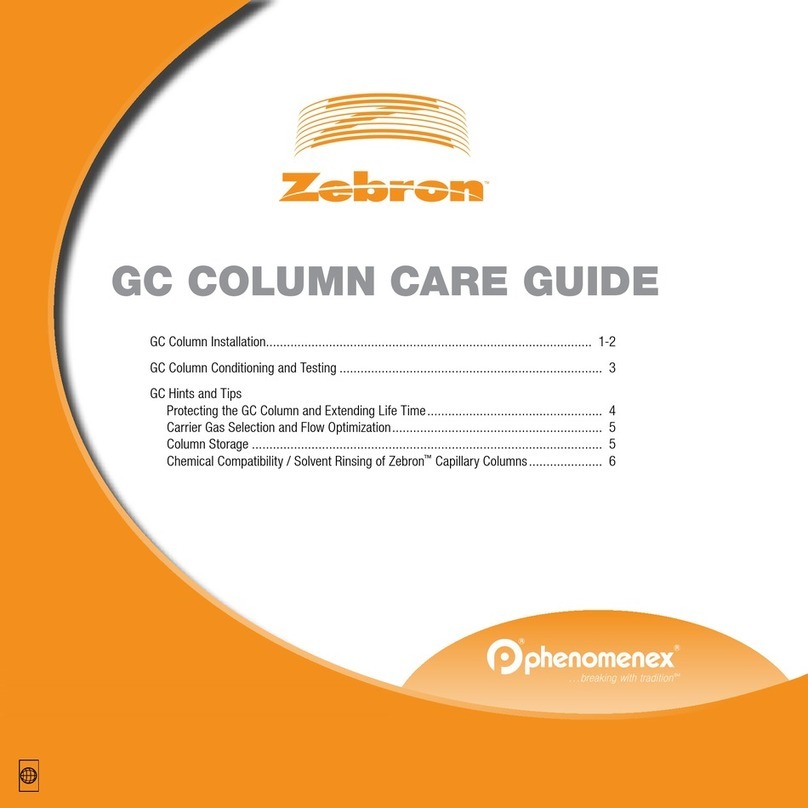
Reversed Phase
Name: Reversed Phase 2 Test Mix
Part No.: AL0-3045
Contents: Uracil, Acetophenone, Toluene, Naphthalene
Solvent: Acetonitrile/Water (65:35 v/v)
Detection: UV @ 254 nm
Injection Vol.*: Depends on dimensions
* See next page for suggested loading capacities based on ID.
Mobile Phase Compatibility
When using any HPLC/UHPLC column, be sure to only use HPLC grade
solvents and materials while also avoiding immiscible solvent/buffer combina-
tions. Additionally, use of solvent ltration is highly recommended to remove
trace impurities from your mobile phase of choice. Gemini NX-C18 columns are
stable in 100% aqueous conditions, but for all Gemini columns please ensure
that mobile phase pH does not exceed individual stationary phase limits. See
chart in column characteristics section for individual Gemini stationary phase
pH limits.
Column Installation
Initial setup of your LC system is very important to ensure column performance:
Ensure that your LC system is ready:
1. Seals, lines, injector clean
2. Lines primed (no dry lines or bubbles)
3. Steady baseline
4. Consistent pressures
Flush LC system pump and line with mobile phase (HPLC grade and
miscible with solvents that column is shipped in).
Mobile phase starting conditions check list:
1. Ensure that HPLC grade mobile phase is well
mixed, ltered, and degassed prior to use.
2. Ensure that column shipping solvent, remaining
solvent in LC system, and mobile phase solvents
are miscible.
Set ow rate to 0.1 mL/min (for 2.1-4.6 mm ID) and install the column making
sure that the arrow is in the direction of ow. Then increase the ow rate to
0.2 mL/min (2.1mm ID) or 1.0 mL/min (4.6 mm ID) for 5-10 minutes. Collect
solvent in a small beaker.
Stop ow and wipe outlet end of column to remove any particulates before
connecting to detector.
Install tting/tubing into outlet end and run minimum 10 column volumes at
low ow (~0.2 mL/min) while monitoring the backpressure.
1. A steady pressure should indicate a constant ow while
pressure uctuation will indicate air in the system.
2. Wide uctuations in pressure may shock and damage
the column so it’s important to monitor the pressure.
Monitor pressure as well as signal from the detector, when both are steady,
the column is ready for use.
Testing Column Performance
When testing column performance, please use the manufacturer approved
test mix.
Column Cleaning
Reversed Phase:
• Clean with a gradient that is closest to the last solvent system on the
system:
For example, if the last injection ended with Buffer/Acetonitrile
(75:25), it's more appropriate to start with 95:5 Water/
Acetonitrile and then move step by step as needed to increase
organic content (i.e. 75:25 Water/Acetonitrileà50:50 Water/
Acetonitrileà5:95 Water/Acetonitrile).
• For hydrophobic or oily materials, try ushing with Isopropyl Alcohol (IPA),
after the column has been ushed with Acetonitrile. When using IPA,
ensure use of a low ow to prevent higher backpressures due to higher
solvent viscosity.
• For materials that are very hydrophobic, try Tetrahydrofuran (THF)
instead.
Tips:
•
When cleaning, set your ow rate lower than that of your method ow rate,
especially when attempting to clean using methanol or IPA.
• Cleaning for a longer period of time is often more benecial than adding
more cycles.
• Working with very high amounts of THF is not recommended especially if
system has PEEK tubing. Cleaning with THF is ne if the tubing are metal.
• Reverse ushing the column (against the direction of the arrow on the
column), but reduce the ow. Here are suggested reverse ush ow rates
based on column ID:
0.1 mL/min (2.1 mm ID)
0.3 mL/min (3.0 mm ID)
0.5 mL/min (4.6 mm ID)
Column Regeneration
Reversed Phase
• Apply the same gradient ush as in the cleaning above, overnight at
low ow.
• Reverse ushing is acceptable.
Column Storage
It is very important to make sure that your column is clean before storage.
This includes removal of buffer, salts, sample, and ion-pairing agents. The
recommended storage conditions are:
• Reversed phase: Acetonitrile/Water (65:35 v/v), Methanol can be used in
place of acetonitrile.





















